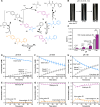Repurposing a Catalytic Cycle for Transient Self-Assembly
- PMID: 39127918
- PMCID: PMC11345760
- DOI: 10.1021/jacs.4c05871
Repurposing a Catalytic Cycle for Transient Self-Assembly
Abstract
Life operates out of equilibrium to enable various sophisticated behaviors. Synthetic chemists have strived to mimic biological nonequilibrium systems in such fields as autonomous molecular machines and dissipative self-assembly. Central to these efforts has been the development of new chemical reaction cycles, which drive systems out of equilibrium by conversion of chemical fuel into waste species. However, the construction of reaction cycles has been challenging due to the difficulty of finding compatible reactions that constitute a cycle. Here, we realize an alternative approach by repurposing a known catalytic cycle as a chemical reaction cycle for driving dissipative self-assembly. This approach can overcome the compatibility problem because all steps involved in a catalytic cycle are already known to proceed concurrently under the same conditions. Our repurposing approach is applicable to diverse combinations of catalytic cycles and systems to drive out of equilibrium, which will substantially broaden the scope of out-of-equilibrium systems.
Conflict of interest statement
The authors declare no competing financial interest.
Figures





Similar articles
-
Chemical engines: driving systems away from equilibrium through catalyst reaction cycles.Nat Nanotechnol. 2021 Oct;16(10):1057-1067. doi: 10.1038/s41565-021-00975-4. Epub 2021 Oct 8. Nat Nanotechnol. 2021. PMID: 34625723 Review.
-
Devising Synthetic Reaction Cycles for Dissipative Nonequilibrium Self-Assembly.Adv Mater. 2020 May;32(20):e1906834. doi: 10.1002/adma.201906834. Epub 2020 Feb 16. Adv Mater. 2020. PMID: 32064688 Review.
-
Chemical-Fuel-Driven Assembly in Macromolecular Science: Recent Advances and Challenges.Chempluschem. 2020 Jun;85(6):1190-1199. doi: 10.1002/cplu.202000192. Chempluschem. 2020. PMID: 32584522 Review.
-
Energy consumption in chemical fuel-driven self-assembly.Nat Nanotechnol. 2018 Oct;13(10):882-889. doi: 10.1038/s41565-018-0250-8. Epub 2018 Sep 17. Nat Nanotechnol. 2018. PMID: 30224796 Review.
-
Fuel-Mediated Transient Clustering of Colloidal Building Blocks.J Am Chem Soc. 2017 Jul 26;139(29):9763-9766. doi: 10.1021/jacs.7b03263. Epub 2017 Jul 14. J Am Chem Soc. 2017. PMID: 28671466
Cited by
-
ATP-Regulated Formation of Transient Peptide Amphiphiles Superstructures.Small. 2025 Apr;21(13):e2410850. doi: 10.1002/smll.202410850. Epub 2025 Feb 25. Small. 2025. PMID: 40007061 Free PMC article.
-
Photoactivated Enzymatic Reaction Network Enables Spatiotemporal Programming of Thiol/Disulfide Redox Systems.Angew Chem Int Ed Engl. 2025 Jun 17;64(25):e202503822. doi: 10.1002/anie.202503822. Epub 2025 May 5. Angew Chem Int Ed Engl. 2025. PMID: 40192652 Free PMC article.
References
LinkOut - more resources
Full Text Sources

